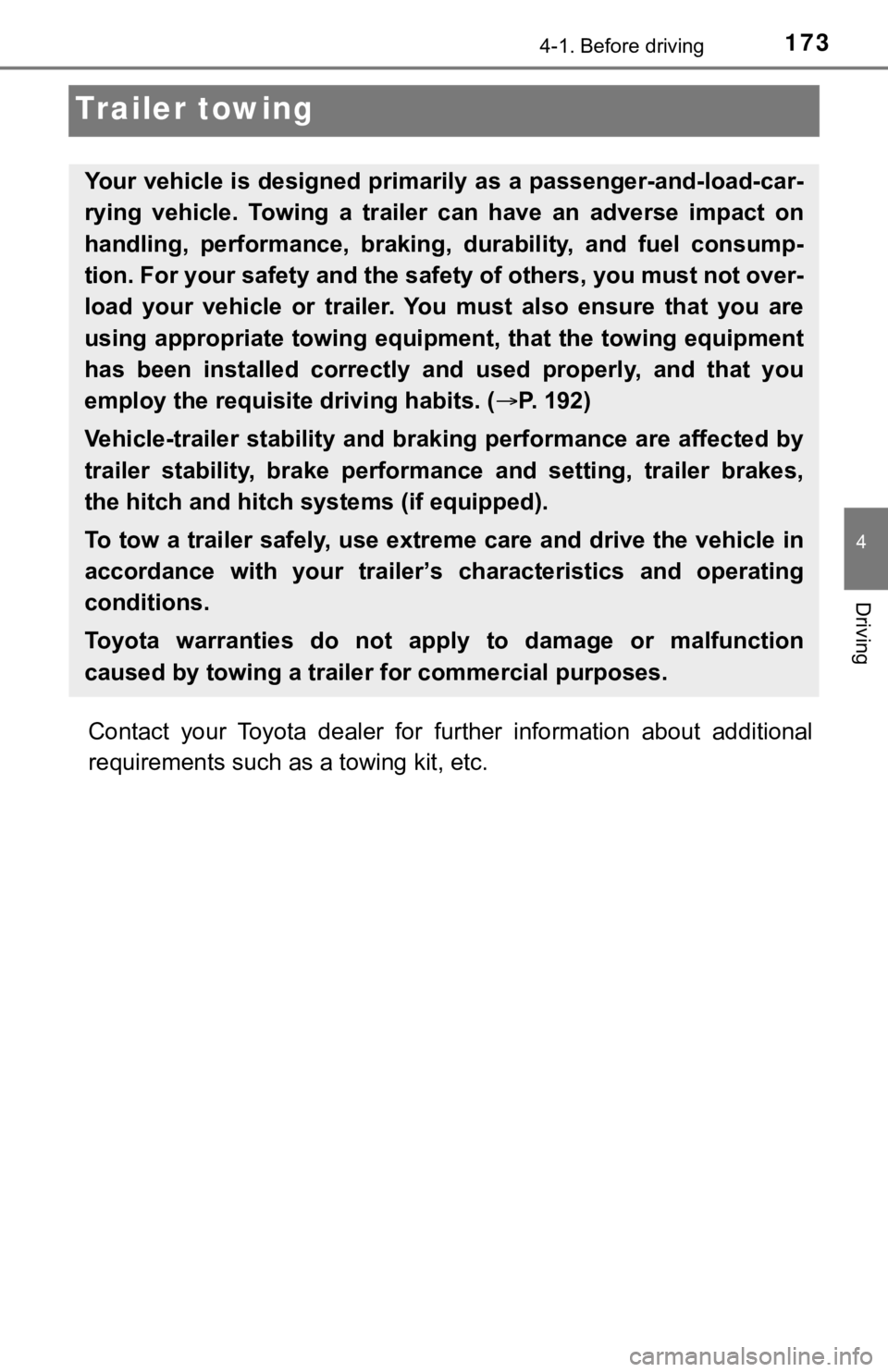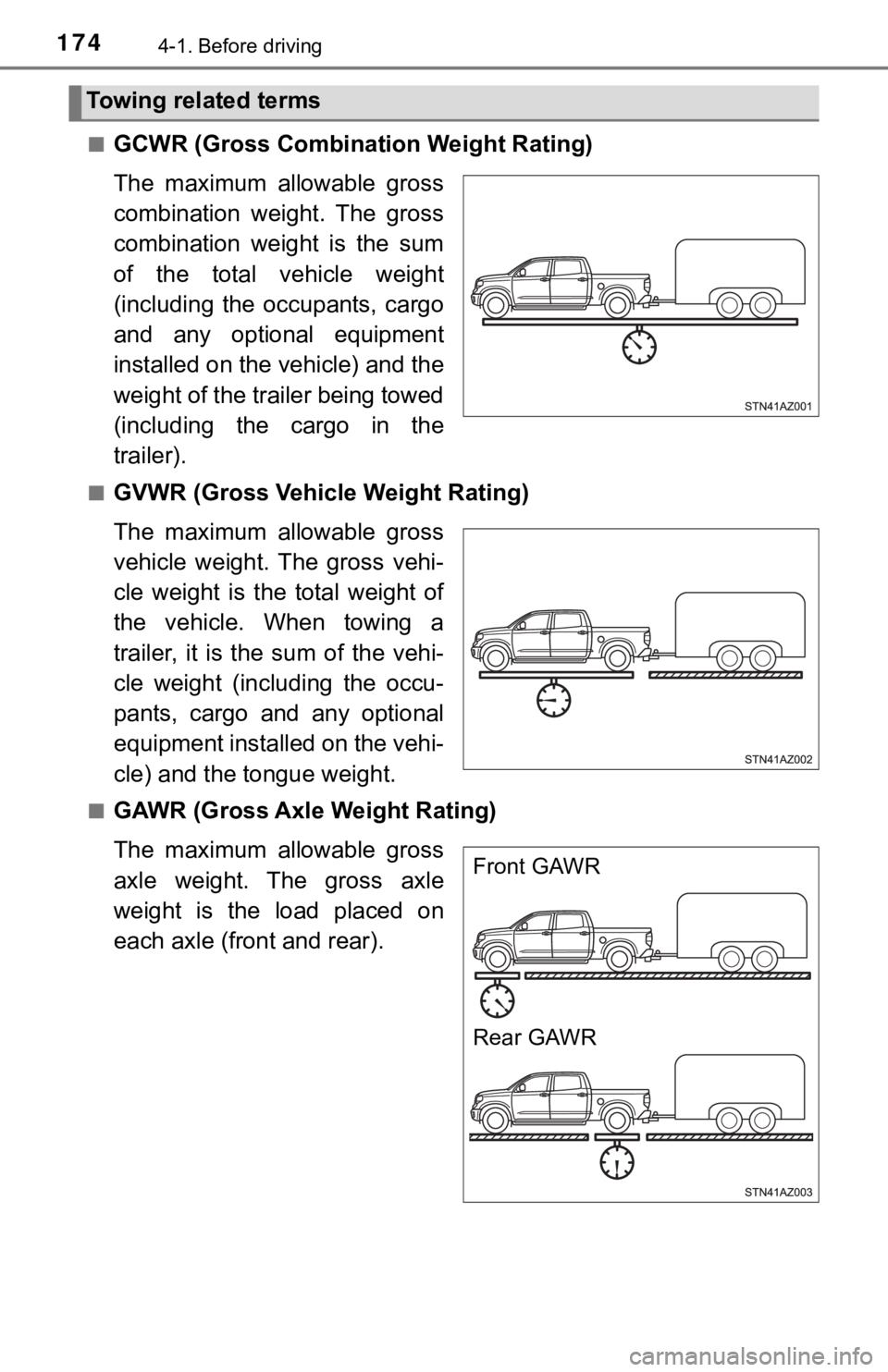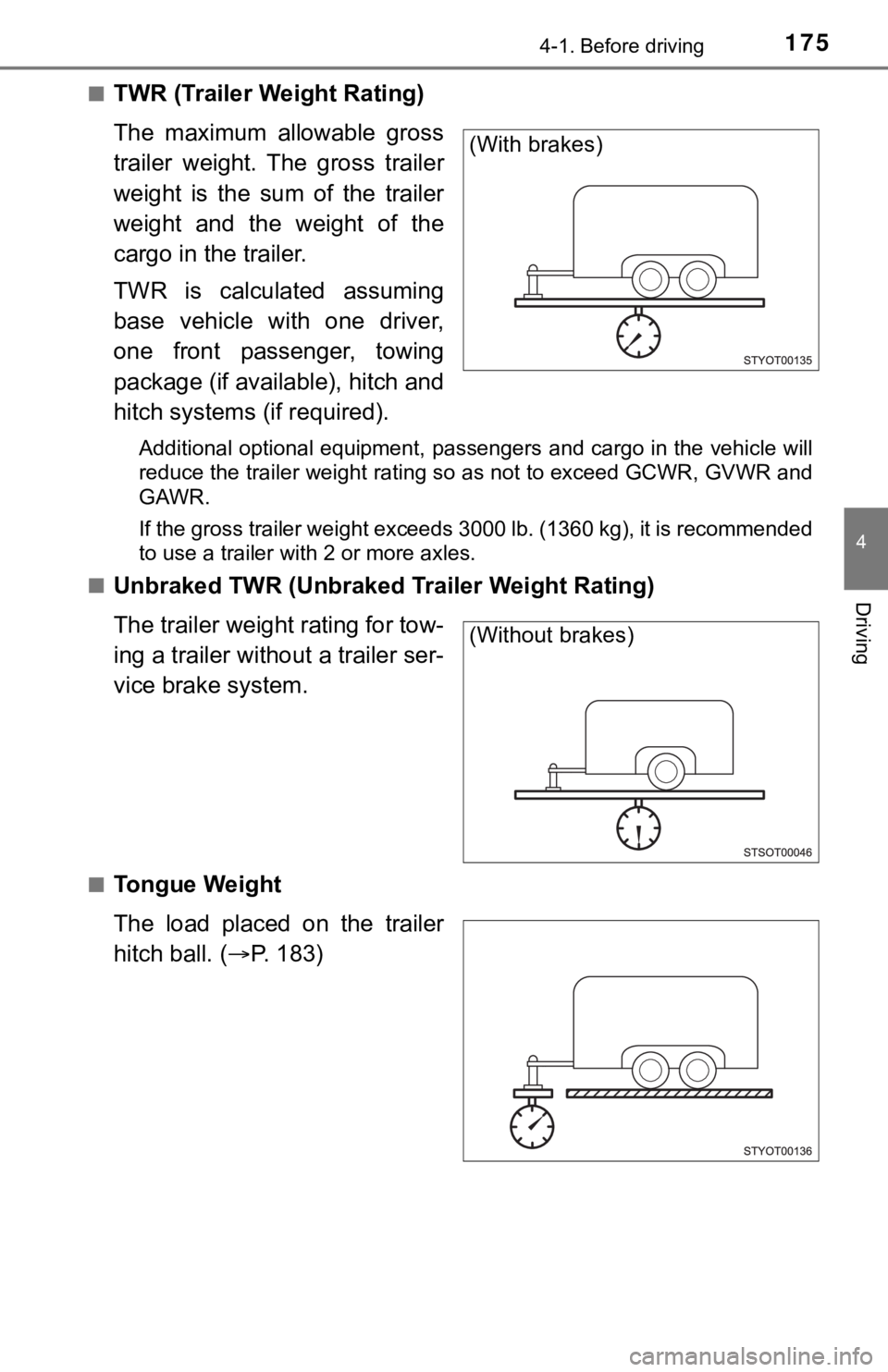2018 TOYOTA TUNDRA towing
[x] Cancel search: towingPage 3 of 672

3
1
9 8
7 5 4
3
2
10
6
4-1. Before drivingDriving the vehicle ............. 160
Cargo and luggage............ 168
Vehicle load limits ............. 171
Trailer towing..................... 173
Dinghy towing.................... 194
4-2. Driving procedures Engine (ignition) switch ..... 195
Automatic transmission ..... 197
Turn signal lever................ 204
Parking brake .................... 205
4-3. Operating the lights and wipers
Headlight switch ................ 206
Automatic High Beam ....... 211
Fog light switch ................. 216
Windshield wipers and washer ............................ 217
4-4. Refueling Opening the fuel tank cap .................................. 220 4-5. Using the driving support
systems
Toyota Safety Sense P ...... 224
PCS (Pre-Collision System) ........................... 231
LDA (Lane Departure Alert) ................................ 244
Dynamic radar cruise control.............................. 252
Cruise control .................... 266
Intuitive parking assist ....... 270
Rear view monitor system ............................. 277
BSM (Blind Spot Monitor)......... 286
Four-wheel drive system ... 296
AUTO LSD system ............ 299
Driving assist systems ....... 301
Trailer brake controller....... 308
4-6. Driving tips Winter driving tips .............. 312
Off-road precautions .......... 316
4Driving
Page 16 of 672

16Pictorial index
■Instrument panel
Front separated type seats
Engine switch . . . . . . . . . . . . . . . . . . . . . . . . . . . . . . . . . . . . . P. 195
Starting the engine/changing the positions . . . . . . . . . . . . . . . P. 195
Emergency stop of the engine . . . . . . . . . . . . . . . . . . . . . . . . . P. 539
When the engine will not start . . . . . . . . . . . . . . . . . . . . . . . . . P. 580
Shift lever . . . . . . . . . . . . . . . . . . . . . . . . . . . . . . . . . . . . . . . . P. 197
Changing the shift position . . . . . . . . . . . . . . . . . . . . . . . . . . . P. 197
Precautions against towing . . . . . . . . . . . . . . . . . . . . . . . . . . . P. 540
When the shift lever does not move . . . . . . . . . . . . . . . . . . . . P. 201
Meters . . . . . . . . . . . . . . . . . . . . . . . . . . . . . . . . . . . . . . . . . . . . P. 95
Reading the meters/adjusting the instrument panel light . . . . . . P. 95
Warning lights/indicator lights . . . . . . . . . . . . . . . . . . . . . . . . . . P. 90
When the warning lights come on . . . . . . . . . . . . . . . . . . . . . . P. 547
Multi-information display . . . . . . . . . . . . . . . . . . . . . . . . . . . P. 100
Display . . . . . . . . . . . . . . . . . . . . . . . . . . . . . . . . . . . . . . . . . . . P. 100
When the warning messages are displayed . . . . . . . . . . . . . . P. 555
Parking brake pedal. . . . . . . . . . . . . . . . . . . . . . . . . . . . . . . . P. 205
Applying/releasing . . . . . . . . . . . . . . . . . . . . . . . . . . . . . . . . . . P. 205
Precautions against winter season . . . . . . . . . . . . . . . . . . . . . P. 313
Warning buzzer/message . . . . . . . . . . . . . . . . . . . . . . . . P. 548, 5571
2
3
4
5
Page 18 of 672

18Pictorial index
Front bench type seat
Engine switch . . . . . . . . . . . . . . . . . . . . . . . . . . . . . . . . . . . . . P. 195
Starting the engine/changing the positions . . . . . . . . . . . . . . . P. 195
Emergency stop of the engine . . . . . . . . . . . . . . . . . . . . . . . . . P. 539
When the engine will not start . . . . . . . . . . . . . . . . . . . . . . . . . P. 580
Shift lever . . . . . . . . . . . . . . . . . . . . . . . . . . . . . . . . . . . . . . . . P. 197
Changing the shift position . . . . . . . . . . . . . . . . . . . . . . . . . . . P. 197
Precautions against towing . . . . . . . . . . . . . . . . . . . . . . . . . . . P. 540
When the shift lever does not move . . . . . . . . . . . . . . . . . . . . P. 201
Meters . . . . . . . . . . . . . . . . . . . . . . . . . . . . . . . . . . . . . . . . . . . . P. 95
Reading the meters/adjusting the instrument panel light . . . . . . P. 95
Warning lights/indicator lights . . . . . . . . . . . . . . . . . . . . . . . . . . P. 90
When the warning lights come on . . . . . . . . . . . . . . . . . . . . . . P. 547
Multi-information display . . . . . . . . . . . . . . . . . . . . . . . . . . . P. 100
Display . . . . . . . . . . . . . . . . . . . . . . . . . . . . . . . . . . . . . . . . . . . P. 100
When the warning messages are displayed . . . . . . . . . . . . . . P. 5551
2
3
4
Page 159 of 672

159
4Driving
4-1. Before drivingDriving the vehicle ............. 160
Cargo and luggage ........... 168
Vehicle load limits ............. 171
Trailer towing..................... 173
Dinghy towing ................... 194
4-2. Driving procedures Engine (ignition) switch ..... 195
Automatic transmission ..... 197
Turn signal lever................ 204
Parking brake .................... 205
4-3. Operating the lights and wipers
Headlight switch ................ 206
Automatic High Beam ....... 211
Fog light switch ................. 216
Windshield wipers and washer ............................ 217
4-4. Refueling Opening the fuel tank cap .................................. 220 4-5. Using the driving support
systems
Toyota Safety Sense P ..... 224
PCS (Pre-Collision System)........................... 231
LDA (Lane Departure Alert) ............................... 244
Dynamic radar cruise control ............................. 252
Cruise control .................... 266
Intuitive parking assist....... 270
Rear view monitor system ............................ 277
BSM (Blind Spot Monitor) ........ 286
Four-wheel drive system ... 296
AUTO LSD system............ 299
Driving assist systems ...... 301
Trailer brake controller ...... 308
4-6. Driving tips Winter driving tips ............. 312
Off-road precautions ......... 316
Page 168 of 672

1684-1. Before driving
Cargo and luggage
Cargo capacity depends on the total weight of the occupants.
(Cargo capacity) = (Total load capacity) (Total weight of occupants)
Steps for Determining Correct Load Limit —
(1) Locate the statement “The co mbined weight of occupants and
cargo should never exceed XXX kg or XXX lbs.” on your vehicle’s
placard.
(2) Determine the combined weight of the driver and passengers t hat
will be riding in your vehicle.
(3) Subtract the combined weight of the driver and passengers fr om
XXX kg or XXX lbs.
(4) The resulting figure equals the available amount of cargo an d lug-
gage load capacity.
For example, if the “XXX” amount equals 1400 lbs. and there wil l be
five 150 lb passengers in your vehicle, the amount of available
cargo and luggage load capacity is 650 lbs. (1400 750 (5150) =
650 lbs.)
(5) Determine the combined weight of luggage and cargo being loa ded
on the vehicle. That weight may n ot safely exceed the available
cargo and luggage load capac ity calculated in Step 4.
(6) If your vehicle will be towing a trailer, load from your tra iler will be
transferred to your vehicle. Consult this manual to determine h ow
this reduces the available cargo and luggage load capacity of y our
vehicle. ( P. 171)
Take notice of the following information about storage precau-
tions, cargo capacity and load:
Capacity and distribution
Page 173 of 672

1734-1. Before driving
4
Driving
Trailer towing
Contact your Toyota dealer for further information about additi onal
requirements such as a towing kit, etc.
Your vehicle is designed primarily as a passenger-and-load-car-
rying vehicle. Towing a trailer can have an adverse impact on
handling, performance, braking, durability, and fuel consump-
tion. For your safety and the safety of others, you must not ov er-
load your vehicle or trailer. You must also ensure that you are
using appropriate towing equipm ent, that the towing equipment
has been installed correctly a nd used properly, and that you
employ the requisite driving habits. (P. 192)
Vehicle-trailer stability and braking performance are affected by
trailer stability, brake performance and setting, trailer brake s,
the hitch and hitch systems (if equipped).
To tow a trailer safely, use extreme care and drive the vehicle in
accordance with your trailer’s characteristics and operating
conditions.
Toyota warranties do not apply to damage or malfunction
caused by towing a trailer for commercial purposes.
Page 174 of 672

1744-1. Before driving
■GCWR (Gross Combination Weight Rating)
The maximum allowable gross
combination weight. The gross
combination weight is the sum
of the total vehicle weight
(including the occupants, cargo
and any optional equipment
installed on the vehicle) and the
weight of the trailer being towed
(including the cargo in the
trailer).
■GVWR (Gross Vehicle Weight Rating)
The maximum allowable gross
vehicle weight. The gross vehi-
cle weight is the total weight of
the vehicle. When towing a
trailer, it is the sum of the vehi-
cle weight (including the occu-
pants, cargo and any optional
equipment installed on the vehi-
cle) and the tongue weight.
■GAWR (Gross Axle Weight Rating)
The maximum allowable gross
axle weight. The gross axle
weight is the load placed on
each axle (front and rear).
Towing related terms
Front GAWR
Rear GAWR
Page 175 of 672

1754-1. Before driving
4
Driving
■TWR (Trailer Weight Rating)
The maximum allowable gross
trailer weight. The gross trailer
weight is the sum of the trailer
weight and the weight of the
cargo in the trailer.
TWR is calculated assuming
base vehicle with one driver,
one front passenger, towing
package (if available), hitch and
hitch systems (if required).
Additional optional equipment, passengers and cargo in the vehicle will
reduce the trailer weight rating so as not to exceed GCWR, GVWR and
GAWR.
If the gross trailer weight exceeds 3000 lb. (1360 kg), it is r ecommended
to use a trailer with 2 or more axles.
■
Unbraked TWR (Unbraked Trailer Weight Rating)
The trailer weight rating for tow-
ing a trailer without a trailer ser-
vice brake system.
■Tongue Weight
The load placed on the trailer
hitch ball. ( P. 183)
(With brakes)
(Without brakes)